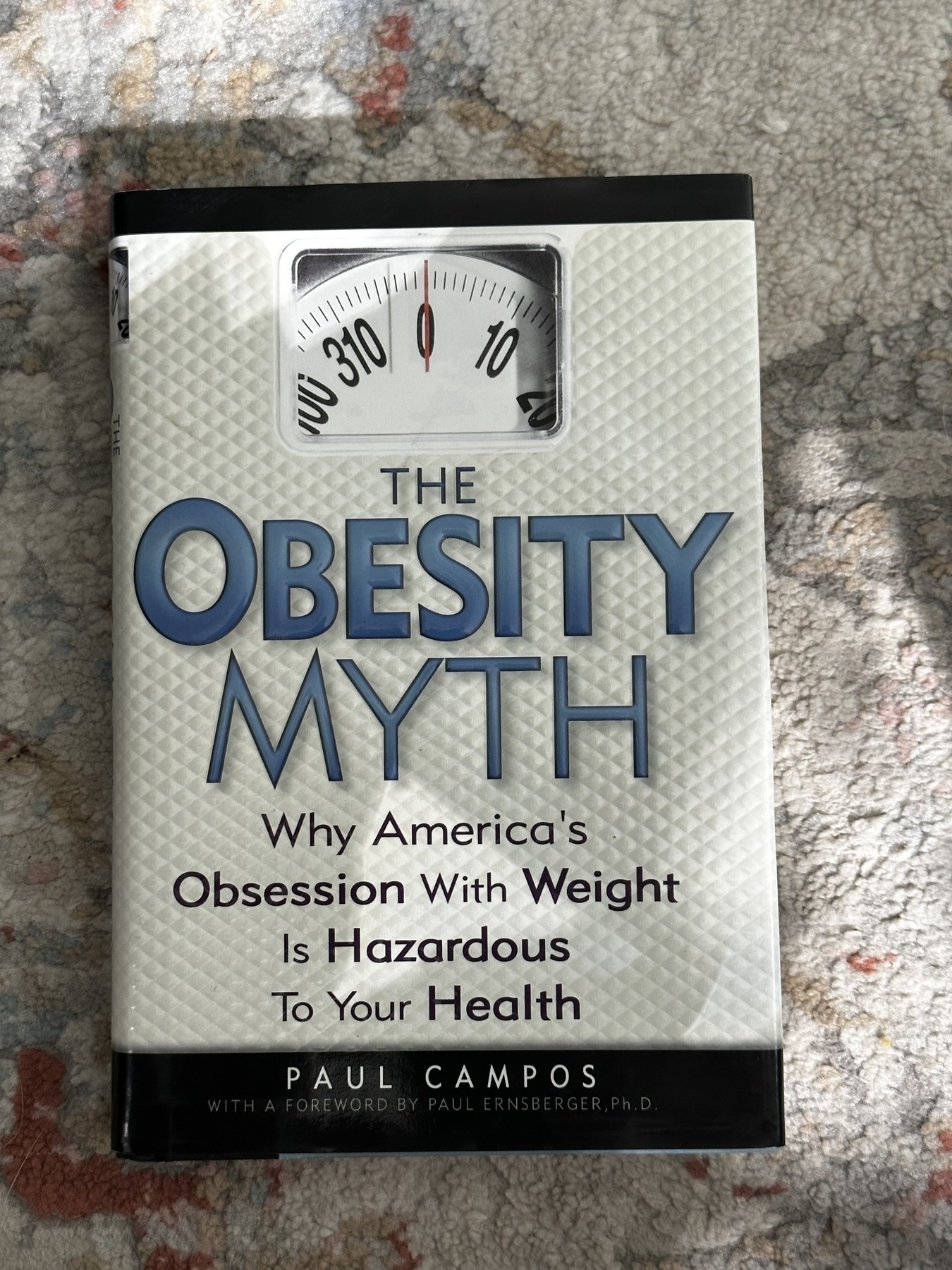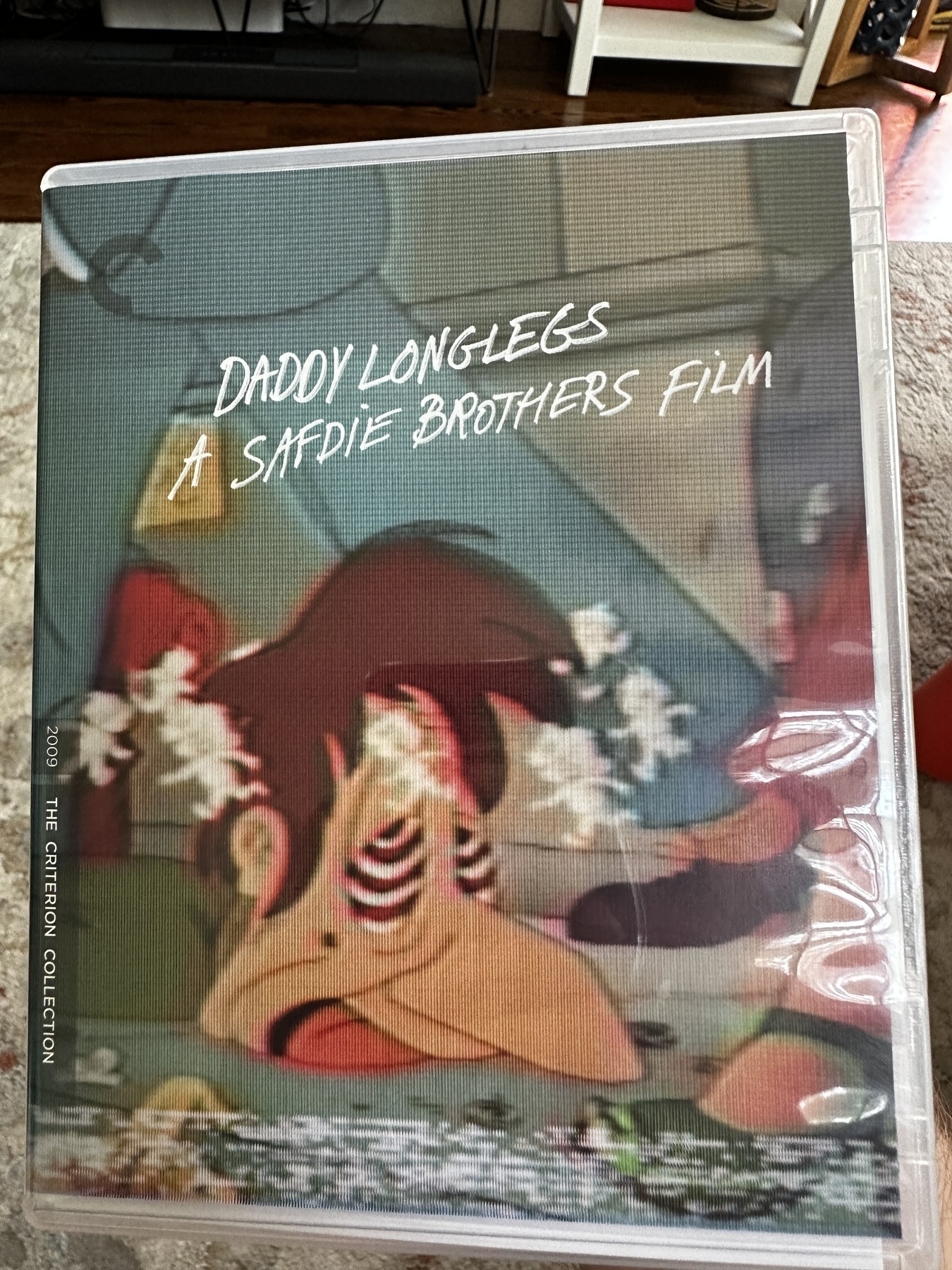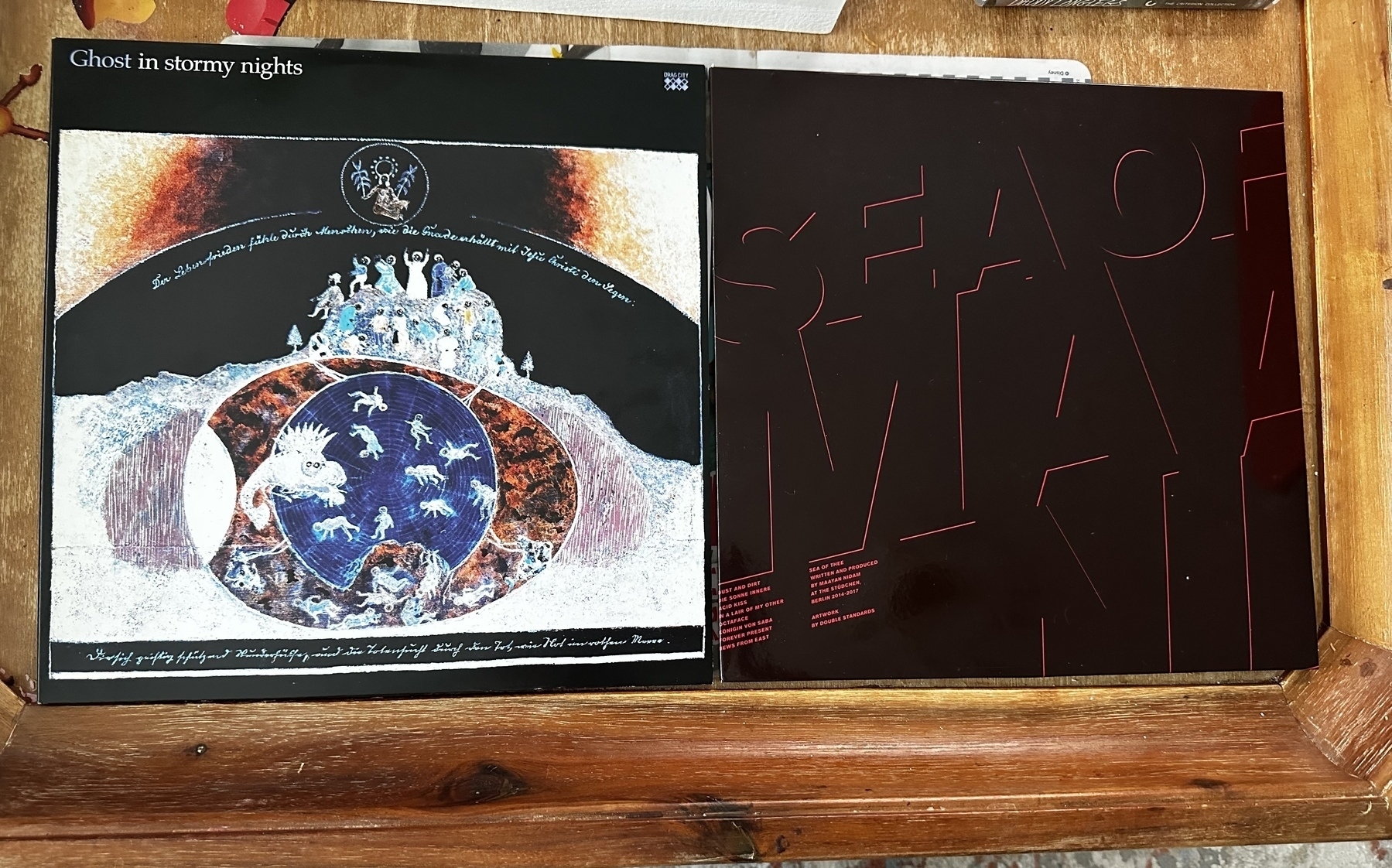-
There’s a lot of media hype about Wegovy that doesn’t grapple with how at its core the drug seems to induce the same harmful weight cycling as every other miracle weight-loss “cure.”
-
Three versions of Pink by Boris:
- 2006 🇺🇸 CD
- 2006 🇺🇸 LP (different sequence, longer versions of 3 songs)
- 2016 deluxe 🇺🇸 CD (extra disc of bonus songs, 🇯🇵 cover art)

-
The Analogue Pocket has 100x (not a typo) the resolution of a Nintendo Game Boy Color (GBC). Here’s the title screen for the rare GBC title Metal Gear Solid, running off the original cart on the system.

-
The agony and the Ear-X-Tacy
Sometime in the mid 1990s, I saw it for the first time—the bumper sticker reading “Ear X-Tacy,” on a car in my school parking lot. That “X” had the mystique of the forbidden, at a time when deep, reflective narratives about Gen-X were widespread, and possibly when Elon Musk was already running the original X.com1. “X” still signified coolness and mystery.
The reality behind this “X” was straightforward but thrilling—Ear-X-Tacy was a vast, single-location record store in Louisville, KY, predominantly stocked with CDs2 that by the time I visited it with my mom a few years later had also gone big into a little new hotness called DVDs. It even carried vinyl, at a time when that format was at its nadir, right before its mid-2000s revival.
Shopping in the physical world
Shopping for music in physical stores like that one is an alien experience for most people under 30. It required immense time and literal energy—i.e., the gas to drive miles away—to go to Ear-X-Tacy, and as such couldn’t come close to the current efficiency of just searching a title in Apple Music and clicking the “+” button.
There’s no space for its mass comeback, and I doubt I’d trade the status quo for it. It’s easy to romanticize it now (and I will in a bit), but the requisite effort is what Don DeLillo might call a “collapsible fact”—something painful (in this case, the inconvenience and expense of CD shopping) that nevertheless gets tucked away as a form of self-defense, only to be recalled (uncollapsed, as it were) later when your nostalgia and/or idealism eventually wears off.
But hunting for CDs did feel challenging and visceral, because you had so much music (more than you could ever get through if you listened nonstop for a month3) at your fingertips as real physical objects, and yet simultaneously you had to work within the sharp physical constraints of the store itself. The experience was unique, such that, even now as a little treat to my nostalgia, I like to go to the Tower Records in Shibuya almost every winter to hunt through its massive rows of special edition Japan CDs4. It’s almost like going back to the mid 2000s again, the twilight of my frequent record-buying experience.
Though it was “only” ~15 years ago, those times seem even more distant than events from much earlier, I suppose because they were so thoroughly physical in away that no longer remotely resembles modern music consumption:
- I’d look up record reviews on Web 1.0 sites such as warr.org. Imagine—reading the opinions of professional critics!
- I’d write down the ones I wanted I to look for on a piece of printer paper. Paper! With pencils and maybe even pens!
- I’d either go with my mom on the drive to Ear-X-Tacy or, if I was in college, walk a ways to the Newbury Comics at a mall near campus. I had to leave the house!
- I’d finger through the CD rows, sometimes but often not finding what I’d been looking for, but also finding things I hadn’t thought of but seemed appealing. Not everything was available on-demand!
- I’d take the discs back to my room (or dorm) and use my desktop PC to rip them into iTunes and then load them onto my iPod. There was no “cloud”!
It took effort, and as painful as it often was, finding something rewarding and having it in your hands was exhilarating—a tangible win in a well-defined game with clear boundaries.
The Zappa conundrum
The artist who dominated those peak CD buying years was one who had at best a contentious and at worst a hostile relationship to the format—Frank Zappa. Record stores almost always organized their collections alphabetically by artist’s surname, so I built muscle memory5 to go to the end of the line and find the day’s almost always massive sample of Zappa’s endless discography.
They’d often have his most popular work—We’re Only In It For The Money, Apostrophe, Freak Out!—alongside some daunting (and expensive) multi-disc works such as Läther and Shut Up N’ Play Your Guitar, and lots of releases you’d probably never even heard of despite your preliminary research, such as Wazoo, a live album containing some but not all material from the much better-known The Grand Wazoo studio album.
Finding a worthwhile6 Zappa release took even more work, but had an even greater reward, than any artist I can recall, not just because there’s a huge gap between his best and worst work, or because he released seemingly 459 albums, but also because in the pre-digital panopticon, pre-smartphone era, it wasn’t always easy to know you’d got the right version of any given album.
Here’s where Zappa’s aforementioned contentious relationship toward the CD comes back in play. When CDs became commercially available in the 1980s. Zappa—like all other major artists of the album era—began remastering many of his LPs. But he went further: He actually re-edited and heavily remixed the recordings, making many of them sound drastically different from the vinyl originals:
- We’re Only In It For The Money had all of its original drum and bass tracks replaced with new recordings that sound badly out of step with the other instrumentation. It also has its censored obscenities restored. The initial CD was different from both the stereo and mono vinyl releases, which were also substantially different from one another.
- Hot Rats had one of this tracks, “The Gumbo Variations,” lengthened by 4 minutes, and its most famous piece, “Willie the Pimp,” re-edited with what sounds like a totally different guitar solo.
- Unless you’d snatched up and held into the original 8-track cartridge of Lumpy Gravy in 1967 when it got recalled, every version thereafter until 2009 was the vastly inferior 1968 re-edit with lots of irritating dialogue added. There was also another version that “punched up” that 1968 mix with re-recorded bass and drums!
There’s way more along those lines. Indeed, the endless possibilities opened up by the CD format—longer run times and greater dynamic range 6, mainly—seemed to overwhelm Zappa, giving him pretext to indulge his tendency to fiddle. Sometimes, limits are good!
I was lucky to walk out of Ear-X-Tacy in spring 2005 with a good mix (the 1995 CD) of We’re Only In It For The Money, I slipped it into a CD player while riding through a hilly stretch between Nelson and Washington Counties in Kentucky, and added it to my iPod later that day. But I also got a “bad” (to some people) mix (the 1987 CD) of Hot Rats and wouldn’t hear the “good” vinyl mix for years (FWIW, I think the CD sounds better).
Physical memories
Those two discs were the soundtrack to my 2005 summer—the drums of “Mom and Dad” echoing in my head while I assembled cars door panels in a factory, the squawking saxophone of “The Gumbo Variations” playing from the car stereo on our road-trips to Rhode Island. I was so careful with them because even then they seemed to embody, in their physical form, a time and place I could literally touch.
Sadly, I lost my Hot Rats disc in a flood this year and only barely saved the We’re Only In It For The Money one and have had to clean it; I think it may still be usable. Either one’s tracks—and all their alternate Zappa remixes, too—are of course still available on every streaming service, but not those exact tracks, on those exact discs, as physical links to distinct memories, and as manifestations of what versions of those albums were deemed the “right” ones at that historical juncture. That’s something that feels like a unique product of the “music store” era, and one that’s literally being washed away.
-
The old X dot com was an online bank that merged with Confinity to make PayPal. ↩︎
-
They even had a Super Audio CD (SACD) section. SACD was a format that required special playback equipment and offered only modest improvements over regular CDs, most importantly the ability to carry up to 6 channels of audio instead of just stereo. But basically nothing except the PlayStation 3 and some Blu-ray players offered a practical way to play them over a good sound system. ↩︎
-
I told a doctor that I had a month plus of music on my iPod in 2008 and I’m pretty sure that even now I haven’t listened to some of the songs in that batch. ↩︎
-
In Japan, CDs often have extra tracks or even extra discs exclusive to the country. ↩︎
-
I typo’d this as “music memory,” and almost left it. ↩︎
-
It’s not an exaggeration to say that with some of Zappa’s worst work, like the 1968 mix of Lumpy Gravy most people couldn’t endure even a single playthrough. ↩︎
-
Don DeLillo, on the last day of summer in Underworld: “It is all part of the same thing, the feeling of some collapsible fact that’s folded up and put away and the school gloom that traces back for decades—the last laden day of summer vacation when the range of play tapers to a screwturn.”
-
Like a 🐅 camouflaged in the jungle

-
Some ☕️ and 🌈

-
Bright red tomatoes from my backyard garden

-
“The economy” isn’t real—but your perceptions are
One of the inescapable meta-narratives of the Biden era had been centrist and center-left writers 1 wondering impatiently why so many Americans think “the economy” 2 is so bad when, in fact, it’s objectively so good. Will Stancil exemplified this tendency recently when he characteristically blamed “media vibes” for distorting Biden’s “economic approval”:
I really think the best explanation [of] Biden’s low economic approval is media vibes. People do not accurately perceive real-world economic indicators around them and predictably adjust their politics. Instead they internalize narrative descriptions of the world, mostly from media.
He has this exactly backward.
In Stancil’s formulation, the supposed real thing is the “real-world economic indicators” that can’t be “accurately” perceived, whereas “narrative descriptions” are fluff—harmful and fanciful distractions (“vibes,” a word meant to silly-ify and diminish their seriousness) from that hard underlying realness of unemployment rates, wage numbers, job openings, and so on. Moreover, “economic approval” gets set aside, presumably from others types of approval (social approval? political approval?), placed above (or maybe below, depending on the spatial metaphors) them as something more fundamental, more real.
But you can’t hold GDP per capita in your hand—after all, it’s a total abstraction, a statistical average! Meanwhile, all of the following things are super-tangible and accordingly easily captured by narratives that in turn resonate with huge audiences:
- The balance in your bank account strained in particular by healthcare costs and other emergencies that are pure products of the U.S. political system. 3
- The very prominent signage (practically a form of advertising) for gas prices, which are virtually unique among consumer goods in being touted in this way. The absolute level doesn’t even matter as much as the sensation of it moving in the “wrong” 4 direction.
- Political sentiments that make you feel like you’re“losing” or “winning” depending on who’s in office, regardless of what’s happening in “the economy.”
It’s the narratives that are the real and powerful things, and the macroeconomic indicators that are fake and impotent in people’s lives. And yet all of the concerns above and any adjacent to them—essentially, anything that strays from the perceived cold hard realness of “the economy” and of the discipline that studies it, economics—are treated as, well, fake news by the Stancils of the world. To them, there’s an objective economic reality out there and people are simply failing to get it because they can’t get out of their own ways.
This viewpoint is reminiscent of two others common on the American left, and you can see contours of both in the incredulity thrown at skeptics of the current U.S. “economy”:
- First, the constant characterization of right-wing climate deniers as idiots ignoring what’s before them.
- Second, the mockery of the belief that Hell awaits anyone who doesn’t grasp what religious fundamentalists deem the “obvious” truth of the Gospels.
Are economy deniers like the clueless climate deniers in no. 1, or are they more like the clueless evangelicals and tradcaths in no. 2? In this case, I think that’s the wrong question—the right one is “why do ‘the fundamentals of our economy are strong!’ proponents sound so much like those zealots in no. 2?”
What even is “the economy”?
Harsh? Sure. But the entire “why don’t they get how awesome ‘the economy’ is?” narrative hinges on a concept as flimsy as that of a mythical deity—that of “the economy” itself.
This term, meant to denote all of the activity in an entire country, only came into vogue after the Great Depression, and its indicators—the ones in which Stancil et al. invest so much value—are quite imprecise. Even the economist Diane Coyle, who wrote a book about GDP, says that the number is more of an idea than a thing. It doesn’t denote any “natural entity,” she says. It’s also somewhat nonsensical—for example, the Sisyphean rebuilding of infrastructure after every hurricane actually boosts Florida’s GDP. It’s good for “the economy,” even!
So “the economy” is a little wonky as a concept, but it’s still fundamentally sound as a meaningful term, about which people should be getting generally similar signals? No. The problem is that by cordoning off something called “the economy,” we act as if:
- There’s something amoral, scientific, and generally objective about it.
- It’s nicely separated from the messier fields of politics, social science, philosophy, art, and so on.
- Being free of such complications, it can be clearly—and uniformly—measured, perceived, and felt.
That’s all really naive. There’s no there there with “the economy”—it isn’t something that’s easily described even by its proponents, such as Coyle above, much less readily (or uniformly!) perceived by the population at-large. People’s own experiences in spheres beyond economics—where they were born, the music they listen to, their cultural heritages, their social circles—inevitably shape what they think about economics. It’d be weird if they didn’t!
Sometimes pundits do latch onto this, although they usually stop short of realizing that fixation on “the economy” is a category mistake. Judd Legum wrote a much more nuanced take than Stancil’s on the “what’s with people thinking the good economy sucks?” phenomenon and identified partisanship as a major reason for differing perceptions:
One factor in Americans' pessimistic view of the economy is partisanship. A study published in The Review of Economics and Statistics in May 2023 concluded that “partisan bias exerts a significant influence on survey measures” of economic conditions, and this influence is “this bias is increasing substantially over time.” Specifically, “individuals who affiliate with the party that controls the White House have systematically more optimistic economic expectations than those who affiliate with the party not in control.”
Think about how bad the Trump years felt if you were on the left, despite the “good” (for the stock market, at least) “economy” (whatever that is). Guess what, that feeling was real and you weren’t simply in denial about some deeper underlying economic truth that you should’ve accepted in such a way that you could compartmentalize everything else—the world is experienced through your total overlapping value system, not just (if even at fucking all) your relationship to economic statistics.
So wondering why everyone isn’t in lockstep, joyously buying into a shared notion of a “great economy” is akin to wondering why everyone hasn’t simultaneously accepted Jesus Christ as their personal lord and savior—given social cleavages and political differences of all kinds, some of them irreconcilable, that was just never going to happen, and you sound like a disappointed and spiteful preacher thinking that it ever would.
Samuel Chambers, in his collection There’s no such thing as “the economy”: Essays on capitalist value, sums up why any meta-narrative about “the economy” that treats it as a standalone domain is mistaken (emphasis mine):
An “economic” event is never just economic, and it never happens only in or to “the economy.” …[T]he so-called “economy,” understood as a discrete object or domain, only comes into existence as a construction of the discipline of economics, after which the very idea of such a place is reified by other disciplines (who explicitly or tacitly accept the idea that “the economy” is what economics studies). Every social order is woven together by threads that are simultaneously economic, political, cultural, and so on. Just as the economic, the political, and the social do not exist in, nor can they be confined to, separate spheres, so too for “values.” There is no moral domain, separable from others. Value systems are themselves built into, developed through, and secreted out of larger social orders. If we want to understand value relations, we cannot look to a discrete object or a separate value sphere; we can only ever look at society. This lines or argument entails the very impossibility of placing “the economy” on an ethical foundation, for the straightforward reason that one of the things “the economy” does is produce and restructure value relations.
So there—stop worrying about why everyone isn’t seeing the light of the wonderful Biden economy, and think about the political and social (and philosophical and moral and so on) reasons for why that might be.
-
I identify as a leftist. ↩︎
-
I’ve put this term in quotes throughout because I think it’s flimsy, as I’ll delve into later. ↩︎
-
A majority of Americans live paycheck-to-paycheck. ↩︎
-
“Are high gas prices good?” is a conundrum for the U.S. left because while high prices discourage driving an ICE vehicle, they also create powerful backlash narratives. ↩︎
-
Essential reading

-
Saw this red bird earlier on top of my 🍅 cages

-
The past isn’t quaint while you’re in it
Many once-ubiquitous customs and behaviors have become so obsolete that it’s puzzling to anyone who didn’t live through them—and maybe even some of us who did—how they were ever so dominant.
Sports gambling was very discreet
Turn on any major sporting event today and you’re likely to get bombarded with information directly from the announcers about betting spreads, “first bet free,” and upset implications. Moreover, many accompanying advertisements are also about gambling. FanDuel, DraftKings, et al. are tightly interwoven with the legitimate sports broadcasting complex. ESPN has licensed its name to a sportsbook maker. Gambling won.
Until the late 2010s, this all would’ve seemed gauche.
Watching a broadcast before then, you’d never know that anyone was betting on the event, much less get direct encouragement to do so yourself. In the 1990s, my grandpa sometimes mentioned moneylines to me, and asked me to look them up in the newspaper, but at that age I didn’t know what was going on, and I didn’t understand the scope of sports gambling until well into adulthood.
Indoor smoking was everywhere
When I was helping out at a bingo at a school around the same time as I was looking up those lines in The Courier-Journal, everyone smoked in the gym where the event was held. The smell went everywhere you went. Restaurants had (indoor) smoking sections.
Courseware? Never heard of it!
A Mastodon post sadly lost to time had a bit in it about how, in the Star Wars universe, the prevailing attitude toward cybersecurity seemed to be “never heard of it.” That was the same attitude colleges had about specialized education software such as courseware, before about 2005.
Indeed, I attended college in the 2000s and it was even then an intensely paper-driven process:
- Class papers were often turned in by dropping them in a faculty member’s department mailbox. Only near the end did email attachments become A Thing.
- All registrations were done by hand in ink on a paper card, until they were replaced after my junior year by a proprietary online system.
- Every course had a paper syllabus that had to be religiously referred to and preserved.
Now? The syllabus is another artifact of the Paper Age, as Ian Bogost explained in The Atlantic:
The syllabus encapsulated the educational side of college life. This wasn’t just a course plan; it was a document that mediated the student’s relationship with the professor. It was a contract, and those who paid that contract insufficient mind—students who might find themselves in breach—were considered lazy, incompetent, or truculent.
Then, 21st-century software upended how courses were run.
Courseware that tracks and updates every aspect of each class is now so embedded into college that you come off as a Certified Old if you say there was a time when it didn’t even exist.
Passwords and sign-ins were rare
Remembering passwords and, if you’re more bleeding-edge, managing 2FA logins and passkeys, is intensely important now. But you used to be able to use a computer all day without ever having to enter a credential to sign into anything.
Let’s say you’re using a Windows desktop 1 in 1996. Your workflow might be:
- Turn on the machine.
- Arrive at the Home Screen.
- Do some work in Microsoft Office and save it to a floppy.
- Print some documents
- Play a game off of a CD-ROM.
- Fiddle with Paint.
- Look at some pre-JavaScript webpages.
Signing into the cloud? Never heard of it.
Console gaming was a lot faster, actually
1995 was my banner year playing the Super Nintendo Entertainment System (SNES). Although gaming has nominally advanced a lot since then, it’s impossible for most modern systems to match the sheer speed at which you could go from not playing to being immersed in a game. We’re talking just a few seconds, to turn on the CRT TV, power on the console, see a title screen, and press Start.
By contrast, modern systems may have to download a patch/update whose file size is bigger than the entire SNES library, before doing anything else. And then loading screens are everywhere. When Mickey Mania came out in 1994, its loading screens were considered painfully slow for the SNES, a console for which it wasn’t even fully optimized. Now those screens would be some of the speediest in console gaming.
Aging was a bigger deal
If you turned 40, people used to act like you were near death. 60? You may as well be mummified. Now there are septuagenarians who are fitter and more active than the 30somethings of the 1980s and 1990s. Modern medicine is astonishing. Lipitor didn’t come to the US until 1996!
Desktop PCs were ascendant
Everyone at my college had a tower desktop PC and a printer connected via serial port. I’d be surprised if anyone there now had a desktop or any kind in their rooms.
Video rentals were big business
The very small town I grew up in once had multiple video rental places. Walls of VHS tapes and SNES and Sega Genesis cartridges. Now physical entertainment media is the outpost of collectors and enthusiasts only.
Edgy white guys, not so much anymore
This one is harder to quantify but I feel like people used to speak in hushed tones about “edgy” white men geniuses such as Kurt Cobain and Lenny Bruce. That moment’s gone and it’s been gone for a while. When a cello duo came to my school in the late 90s, they were astonished that most of the audience had never heard of Nirvana.
-
I’ve always preferred Macs but I use a Windows example here because that’s what we had at the time and that era was the nadir of Apple’s business. It almost went bankrupt in 1997! ↩︎
-
The Old New Memories
Sometimes, events from many years ago can feel much closer to the present than much more recent ones. I was thinking about how just 6 years ago, Steve Bannon was a White House adviser and Mike Pence VP, and both of them apparently on good terms with then-President Trump. 1 Now you couldn’t gather the three in a room together without fisticuffs. The reality in which they were all somehow chummy feels like it may as well have happened during the Napoleonic Wars:
- Pictures from that era already have that dated look of several-times-superseded digital photography (the iPhone 7 was the latest generation at the time).
- Places I visited while fretting constantly about the carnage of the Trump-Pence WH have long since shut down, and so I feel like my one-time very tangible worries are now shapeless, homeless memories with no anchor in physical space.
- It wasn’t far from the COVID era (only 2 years and change!), so the immediacy to that rupture puts its datedness in even sharper relief.
And yet a The Mars Volta concert I went to more than 18 years ago—that feels like it just happened.
Like a lot of the music I discovered in the mid-2000s, I found out about them via Pitchfork, a music site now owned by Condé Nast but back then still indie and staffed by people as convinced of their own righteousness as any Twitter or Bluesky shitposter who thinks their addiction to what amounts to a digital casino gives them superior insights and even credentials as some kind of enlightened, hardened online laborers. Although I found and purchased plenty of albums on account of positive Pitchfork review, it was a nominally negative review of the first Mars Volta LP—penned by the same guy who wrote the worst album review ever—that drew me in:
The Mars Volta mistake sonic piling for complex architecture. No melodic themes are carried. Often you’ll find yourself lost in a epic passage of dripping noises (“Cicatrix ESP”) or a robotic bleepdown (“Take the Veil Cerpin Taxt”) where the song even forgets itself, before the opening riff and chorus blare back in an “oh, right, this one” kind of way. Even acoustic interludes, like the one during the opening of “This Apparatus Must Be Unearthed”, can’t pass without Amazon bird recordings and distant e-bow.
Amazon birds? Epic passages of dripping noise? Where do I sign up?
Both that album (De-Loused in the Comatorium) and its follow-up (Frances the Mute) were the soundtracks to my hazy March 2005, a month of major awakening and pain in which I began struggling with academic work but also saw a path toward a new identity and life as a 🏳️🌈 person. I’ll always remember blasting “The Widow” while working on art projects in my dorm.
Maybe it’s that association of the band’s music with a pivotal moment in life that makes even a concert from 2005 feel so immediate in my memory, more so than the much more recent Trump-Bannon-Pence triumvirate. That, and the fact that I have no photos or recordings of it, nothing to go on but my thoughts. So it’s a distinctly analog experience that has to be recreated anew from the raw materials of the mind forge each time.
The way the human brain works is that it doesn’t store perfect digital copies of anything that can be transported and recontextualized outside of the body that it’s apart of. One person’s memory is unique, even of events simultaneously experienced by numerous others. Accordingly, it’s possible that the aforementioned context made me uniquely predisposed to be blown away by that concert, at which they opened with a 20-minute song and ended with a 32-minute one, with their relatively concise “hits” (used loosely) “The Widow” and “L’Via L’Viaquez” sandwiched in between.
Was it really that great, objectively? Who can even say, given how each of our minds contextualizes and evaluates events differently? I’ll conclude with a passage from one of my favorite essays on this subject, “The Empty Brain”:
Whereas computers do store exact copies of data – copies that can persist unchanged for long periods of time, even if the power has been turned off – the brain maintains our intellect only as long as it remains alive. There is no on-off switch. Either the brain keeps functioning, or we disappear.
-
I’ve been watching Jonny Quest while working out and it’s very distracting how the show has a character named “Race Bannon” who is a dead ringer for a fitter Mike Pence. He also features in a few episodes of the Adult Swim show The Venture Bros. ↩︎
-
🐝 🌼

-
It was so tough to quit Twitter even in the Musk era, because it felt like a news source unique in both its depth and velocity. Now I realize that wasn’t true—I was just addicted to the dopamine 🎰. Plus, all that news was filtered thru the excruciating minutiae of intra-platform feuds and egos.
-
If I had to propose just one cause of 🇺🇸 ‘s current ills, it’d be cars—not only due to the environmental and health damage, but also because the land-use patterns they drive (everything’s far away, across a sea of traffic, noise, and danger) make it much harder to build and sustain friendships.
-
Now we’re all gamblers in the ESPN casino
ESPN—yes, the U.S. cable sports network—once offered a mobile phone plan.
In late 2005, the company launched Mobile ESPN, a sports-centric service delivered directly from the Bristol, Connecticut-based company to devices such as the Samsung ACE, via ESPN’s capacity as a mobile virtual network operator using extra capacity from Sprint 1. This expensive package—it could cost as much as $225 per month—also included voice and data alongside access to push notifications (e.g., about game scores) and live event coverage from ESPN, all of it a true novelty on handsets in the mid-2000s.2
Steve Jobs infamously called Mobile ESPN “the dumbest fucking idea I ever heard.” It shut down in late 2006, right before the original iPhone was unveiled in January 2007. Neat narrative, right?
Mobile ESPN was the future after all
But even though smartphones obviated the immediate utility of anything resembling the Mobile ESPN paradigm—wherein the “intelligence” is all server-side and the device is essentially just a dumb terminal, rather than the reverse, as seen with the iPhone in particular as well with the current trend toward on-device “AI” 3—the infrastructure built in 2005-2006 helped ESPN launch one of the most used and influential mobile apps. Moreover, Mobile ESPN looks in retrospect like a proto-streaming service—a hedge against the possible unfurling of the cable/satellite TV bundle, of which ESPN has long been the star and the most expensive single component.
Mobile ESPN revealed not only ESPN’s urge to be at the technical forefront (even with technology that wasn’t economically practical), but also the anxiety the company felt about the almost too-good-to-be-true economics of cable/satellite TV. It saw mobile phones as a potential threat to that business, and Mobile ESPN was its beachhead. To recap, cable/satellite TV is the perfect business model:
- If you’re a content maker like ESPN, providers such as Comcast and Charter pay you for the right to carry your channel.
- You can also run ads on your channel!
Streaming may seem so technologically modern in comparison, but it’s nowhere near as lucrative as pay TV—with these dual income streams—was at its peak. Disney+, Max, and Peacock all lose money or barely eke our a profit each quarter. ESPN even now as a cable/satellite-only channel 4 is still very profitable, but cord-cutting (i.e., the ditching of pay TV in favor of streaming services) has diminished both its reach and its bargaining clout. The New York Times recently documented how much ESPN would have to charge if it went “direct to consumer,” i.e., sold its main channel as a standalone streaming service rather than requiring people to purchase a pay TV bundle:
Estimates vary widely, but if ESPN offered its cable channels à la carte, it would most likely have to charge an astonishingly high fee for the streaming service, perhaps $40 or $50 per month, just to maintain its current revenue.
$50!!! Complaining about the high costs of pay-TV packages is practically an American tradition, but paying that much for one channel would be unheard of, not to mention insulting when even at this late date a basic cable bundle that includes ESPN and many other channels can still be had for less than $100.
Yet, according to Disney CEO Bob Iger, the standalone ESPN is a matter of when, not if. To me, the streaming ESPN feels like Mobile ESPN redux because it’ll be:
- Way too costly for the average consumer.
- Clunky and unreliable, if the Disney+ and Hulu interfaces are anything to go by.
- Likely to be superseded by some kind of bundle or streaming-native service, in the same way the iPhone was sort of a “bundle” or cheap apps in its early years, one that easily outstripped the dumb phones that Mobile ESPN was built for.
- Still fundamentally valuable, in that it’s delivering in-demand “content,” in this case, live sports.
Enter the gambler
At the same time that it’s trying to become a streaming service, ESPN is also taking on the characteristics of social media. It recently licensed its name to Penn Entertainment, a gambling company that can now operate sports books under the ESPN brand. In a previous post, I likened the major social media platforms to gambling, because they’re both addictive and unlikely to provide consistent return for your effort—so you should see your posting efforts as charity rather than labor, and not get too invested in them, in the same way that you’re better off just tossing a relatively few coins into slots at a casino instead of going (literally) all-in trying to change your life there.
Now ESPN will be essentially a vertically integrated gambling operation, offering coverage of sporting events alongside branded sports books and commentary that highlights betting lines, available betting services, and so on. Writing for The Atlantic, Amanda Mull sums up how complete the victory is for the sports gambling complex over the once-gambling averse North American sports leagues and the media that cover them, all of whom need this money to make up for the decline of cable/satellite and the unsuitability of streaming revenue as a replacement:
Although ESPN in particular is still enormously profitable—to the tune of billions of dollars a year—the decline of cable has made continued growth look difficult, and growth is what shareholders want. No matter how creatively you do the math, streaming subscriptions are unlikely to make up the difference. Media executives go where the money is, and right now, the biggest piles of new money are available to those who encourage viewers to gamble. If even ESPN can’t hold out, and apparently has no desire to try, then no one can.
Sports gambling was social media before “the Facebook” was a twinkle in Mark Zuckerberg’s eye, in that it instilled both FOMO and compulsive behavior, and this integration of ESPN with Penn only exacerbates this characteristic of it by making any consumption of sports content going forward a potentially anxiety-ridden, Web 2.0-esque experience in having to contribute your own part—you can no longer just passively watch, you have to get in on the literal action by betting.
Just as social media can be understood as the replacement of paid newspaper and magazine subscriptions with free ad-supported and engagement-driven websites, the new gambling-centric ESPN can be seen as the replacement of the pay-TV package with tons of gambling cash, both directly from casino operators and indirectly from the individuals who’ll feel the need to gamble.
It’s like social media, in that it makes us feel like we’re workers or even entrepreneurs on the verge of riches, when in reality we’ve become lost in non-remunerative addiction. The only way to win is not to play; you have to have the courage to pull an Elaine Benes in “The Bizarro Jerry” and say:
I can’t spend the rest of my life coming into this stinking apartment [my note: replace with website, channel, app, whatever] every ten minutes to pore over the excruciating minutiae of every single daily event!
-
Nothing makes me feel older than saying that ESPN used to operate a MVNO from a carrier that no longer exists, with Sprint having been absorbed into T-Mobile. ↩︎
-
In 2006, whirl away from home at Yu-Gi-Oh! tournaments, I checked sports scores on my Motorola RAZR with a weird Java app that was costly if I used it for more than a few minutes. ↩︎
-
I put “AI” into quotes because I think it’s a misnomer that assigns too much agency to the rote practice of applied statistics. ↩︎
-
ESPN+ is a streaming service, but it has a much smaller catalogue of high/profile events that ESPN proper. ↩︎
-
Watched Daddy Longlegs by the Safdie brothers. Tense, terrifying, and yet funny in their distinctive style, even more so than Uncut Gems. The extras on the Blu-ray are fascinating, including a fake CNN spot about Benny Safdie (Edward Teller in Oppenheimer!) boarding a plane to rapturous applause.

-
Today’s morning listens:
- In Stormy Nights by Ghost: This vinyl edition of this psychedelic band’s final album has a different sequencing and one extra track compared to the digital edition.
- Sea of Thee by Maayan Nidam: A characteristically great record from the Perlon label.

-
Batteries not included (or required)
AirPods seem like such a fixture of our world that it’s weird to think they debuted only seven years ago. In that short time, they’ve not only become ubiquitous 1 but have reshaped social norms around:
- Disposability: The batteries in AirPods are small and thus short-lived. Within a few years, they won’t hold a charge—and they’re not user-serviceable.
- Music quality: AirPods use Bluetooth, which is as Steve Jobs himself might’ve said, “a bag of hurt.” It doesn’t support lossless quality—something Apple Music has marketed as a big differentiator vis-à-vis Spotify—and it often introduces noisy wireless interference that’s never plagued wired headphones.
- Social isolation: Whereas wired headphones send a clear signal (pun intended!) to the outer world that you were listening to something or talking to someone, AirPods don’t. They’re hard to see from some angles and overall very small.
Ian Bogost examined the third issue in depth in 2018, talking about how AirPods—by being so inconspicuous—pointed to a world in which we withdraw more and more into our devices, a prediction that now seems dead-on given the upcoming Vision Pro:
[E]arbuds will cease to perform any social signaling whatsoever. Today, having one’s earbuds in while talking suggests that you are on a phone call, for example. Having them in while silent is a sign of inner focus—a request for privacy. That’s why bothering someone with earbuds in is such a social faux-pas: They act as a do-not-disturb sign for the body. But if AirPods or similar devices become widespread, those cues will vanish. Everyone will exist in an ambiguous state between public engagement with a room or space and private retreat into devices or media.
I’ll add that they also amplify anxiety. They make certain critical sounds, such as those from car engines, less audible, meaning possible danger becomes less apparent and multitasking—withdrawing into music while looking out for threats—more stressful. And then there’s the mercurial battery life, which can vary widely between each individual pod.
One time I showed up at the gym thinking I had a full charge in both of them, but one was totally empty despite its indicator, and so I could only listen in mono 2 for an hour of exercise. I was in “private retreat” as Bogost describes it, but only partially because I wasn’t isolated in what I really wanted. So I had neither isolation nor immersion in the moment—just someone talking in (one of) my ears.
Discharged from anxiety
That event plus my overall awareness of how rapidly AirPod battery life declines has made me a wired headphone acolyte anew. It’s like 2004 again when I wore the white earbuds that came with my click wheel iPod.
Seriously, if wired headphones didn’t already exist, you’d sound like either a genius or a madman pitching the idea of a device that:
- Never has to be charged
- Easily handles a lossless signal
- Can fit comfortably in your pocket
They’re almost too good to be true when conceived of in this way. And I’ve embraced this freedom from batteries elsewhere, too.
I got an Apple Extended Keyboard II that’s fully powered by its Apple Desktop Bus connection to my iMac 3, unlike the stock keyboard that comes with the computer. For my Nintendo Switch, I use the HORI Split Pad Compact in handheld mode—it’s more comfortable than the Joy Cons, has a proper D-pad, and never has to be charged.
These battery-free connections reduce one source of anxiety—will my AirPods work, are my controllers ready, do I need to recharge my keyboard—and remind me that there’s no such thing as total isolation. The type of wireless retreat into fantasy that Bogost feared is just that—a fantasy that’s built on the notion that we don’t even need a literal lifeline to something else, that we can really just power on our own with our short-lived batteries.